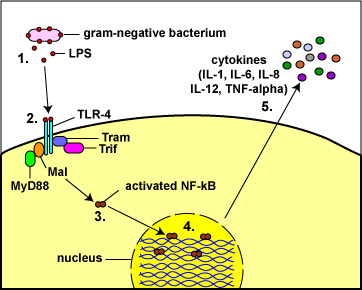
(1) The lysis of gram-negative bacteria
causes them to release lipopolysaccharide (LPS; endotoxin) from the outer membrane
of their cell wall.
(2) The LPS binds to a pair of TLR-4s on the macrophage.
(3&4) This enables regulatory molecules within the cell - Mal, MyD88, Tram,
and Trif - to trigger reactions that activate a master regulator of inflammation
called NF-kappa B. Activated NF-kappa B enters the cell's nucleus and switches
on genes coding for cytokines such as:
a. Interleukin-1 (IL-1) and Tumor necrosis factor-alpha (TNF-alpha): enhance inflammatory responses;
b. Interleukin-8 (IL-8): aids in the ability of white blood cells to leave the blood vessels and enter the tissue; a chemoattractant for phagocytes;
c. Interleukin-6 (IL-6) promotes B-lymphocyte activity; and
d. Interleukin-12 (IL-12): promotes T-lymphocyte activity. (5)
Last updated: August, 2019
Please send comments and inquiries to Dr.
Gary Kaiser